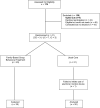Evaluation of a group-based behavioral intervention to promote adherence in adolescents with inflammatory bowel disease
- PMID: 21989119
- PMCID: PMC3233635
- DOI: 10.1097/MEG.0b013e32834d09f1
Evaluation of a group-based behavioral intervention to promote adherence in adolescents with inflammatory bowel disease
Abstract
Objective: To pilot test the feasibility and acceptability of a family-based group behavioral intervention and to improve medication adherence in adolescents diagnosed with inflammatory bowel disease.
Methods: Participants were 40 adolescents aged 11-18 years diagnosed with inflammatory bowel disease and their primary caregivers, who were randomized to either a four-session Family-Based Group Behavioral Treatment or Usual Care over a 6-week period. Adherence was measured using a multi-method, multi-informant assessment involving caregiver-report and patient-report, pill count data, and electronic monitoring.
Results: Adherence rates ranged from 66 to 89% for 6-mercaptopurine/azathioprine and 51 to 93% for mesalamine across assessment methods. The intervention was feasible, as evidenced by the 99% treatment session attendance rate, and acceptable based on patient and caregiver report. Repeated measures analysis of variance tests revealed nonsignificant differences between the conditions from baseline to post-treatment assessments for pill count, electronic monitor, and primary caregiver-reported adherence (P's>0.05). There was a statistically significant improvement in patient-reported mesalamine adherence represented by a significant main effect for Condition (F=22.24, P<0.01; δ=0.79) and Condition×Time interaction (F=13.32, P<0.05; δ=0.69).
Conclusion: Findings suggest potential for use of behavioral intervention to improve medication adherence in this population. This intervention may be more effective with more complex regimens (e.g. multiple doses per day) such as those prescribed with mesalamine. Further research is needed to examine this type of intervention in more diverse samples with more active disease. Use of alternative adherence measurement approaches, including electronic pill boxes and/or real-time self-report (e.g. by text messaging, electronic diaries, etc.) is also recommended.
References
-
- Kappelman MD, Rifas-Shiman SL, Kleinman K, et al. The prevalence and geographic distribution of Crohn's disease and ulcerative colitis in the United States. Clin. Gastroenterol. 2007;5(12):1424–1429. - PubMed
-
- Auvin S, Molinie F, Gower-Rousseau C, et al. Incidence, clinical presentation and location at diagnosis of pediatric inflammatory bowel disease: a prospective population-based study in northern France (1988-1999). J. Pediatr. Gastroenterol. Nutr. 2005 Jul;41(1):49–55. - PubMed
-
- Otley A, Smith C, Nicholas D, et al. The IMPACT questionnaire: A valid measure of health-related quality of life in pediatric inflammatory bowel disease. J. Pediatr. Gastroenterol. Nutr. 2002 Oct;35(4):557–563. - PubMed
Publication types
MeSH terms
Substances
Grants and funding
LinkOut - more resources
Full Text Sources


